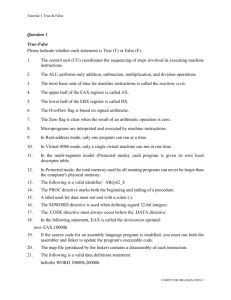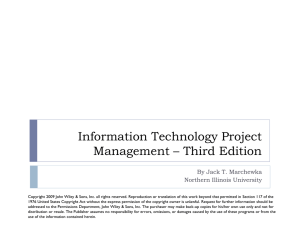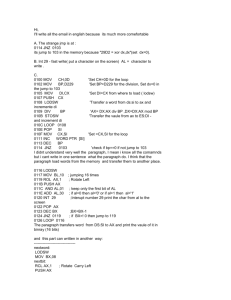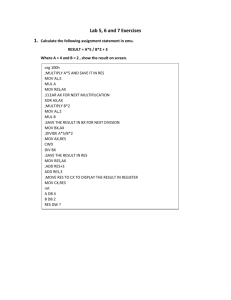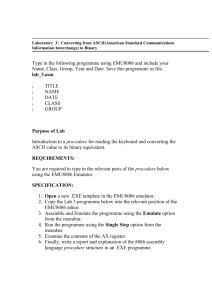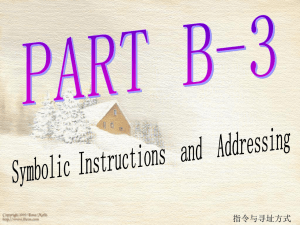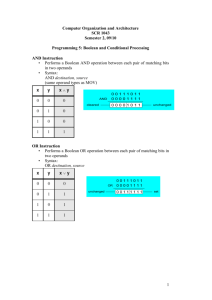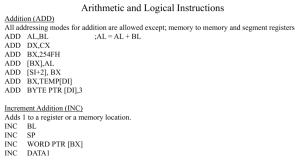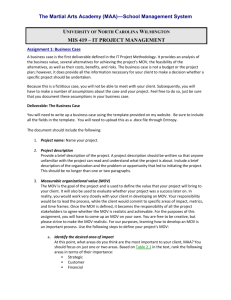LAB3
advertisement
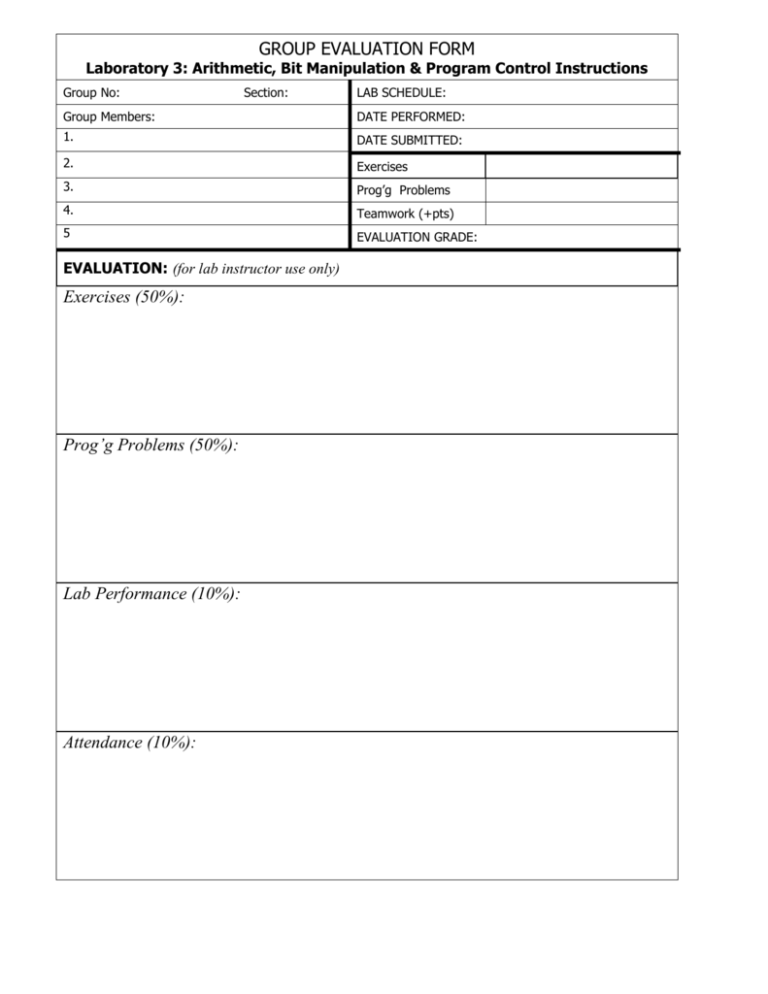
GROUP EVALUATION FORM
Laboratory 3: Arithmetic, Bit Manipulation & Program Control Instructions
Group No:
Section:
LAB SCHEDULE:
Group Members:
DATE PERFORMED:
1.
DATE SUBMITTED:
2.
Exercises
3.
Prog’g Problems
4.
Teamwork (+pts)
5
EVALUATION GRADE:
EVALUATION: (for lab instructor use only)
Exercises (50%):
Prog’g Problems (50%):
Lab Performance (10%):
Attendance (10%):
LABORATORY 3B
3A
Bit Arithmetic
Manipulation
Instructions
Instructions
I. REQUIREMENTS:
1.
2.
Do the following exercises using the different programming tools.
Attach source code hard copy of programming problems solutions.
II. COMPONENTS TO BE BORROWED
PC power cords (2)
Keyboard (1)
Mouse (1)
III. A PROCEDURE:
1. Run the DEBUG or Emu8086 program
2. Assemble the given program written on the table.
3. Run the above program in step mode (using TRACE commands) and examine the effects on the flag bits.
Write your observation by completing the table below:
Instruction
AX
Register Content
CX
DX
Flag Register
IP
Prior to execution
MOV AX, 1832H
MOV CX, 342FH
MOV DX, 56BAH
ADD AX, CX
SUB AX, DX
MUL CL
DIV DL
IV. A PROGRAMMING PROBLEMS:
1.
Write an assembly program will calculate the given arithmetic expression. The final result must be stored at
AX.
AX= (1234h + 1000h – 0FFFh)*000Ch/000Ah
2.
Write an assembly program that will add the data located at DS:0000 to DS:0009 and DS:000A to DS:0013.
Store the sum at location DS:0014 to DS:0022.
Address
DS:0000
01
02
03
04
05
06
07
08
09
0A
DS:000A
0B
0C
0D
0E
0F
10
11
12
13
14
DS:0014
0C
0E
10
12
14
16
18
1A
1C
1E
3. Write an assembly program that will add two BCD numbers.
Example:
AL =
BL =
AL =
jtio
15h
15h
30h
2
LABORATORY 3C
Program Control Instructions
III. B PROCEDURE:
1. Run the DEBUG or Emu8086 program
2. Assemble the given program
MOV AX, 1832H
MOV DX, 342FH
MOV CX, 56BAH
AND AX, CX
XOR CX, DX
MOV CL, 4H
ROR DX, CL
3. Run the above program in step mode (using TRACE commands) and examine the effects on the flag bits.
Write your observation by completing the table below:
Instruction
AX
Register Content
CX
DX
Flag Register
IP
Prior to execution
1. MOV AX, 1832H
2. MOV DX, 342FH
3. MOV CX, 56BAH
4. AND AX, CX
5. XOR CX, DX
6. MOV CL, 4H
7 ROR DX, CL
IV. B PROGRAMMING PROBLEMS:
1.
Write an assembly program that will clear the least significant nibble, set the most significant nibble and
retain the values of the rest of the bits of AX.
Example:
Prior to execution:
AX = ABCDh
After execution: AX = FBC0h
2.
Write an assembly program that will simulate the given Boolean expression using assembly
programming.
AL = (AL∙ BL + AH∙ BH)’ xor (CH+(CL∙ DL)’ ∙ DH)’
3.
Write an assembly program that will check if the P (Parity bit) will result to PO (Parity Odd) or PE(Parity
Even) using bit manipulation instructions.
III.C PROCEDURE:
jtio
3
1. Run the DEBUG or Emu8086 program
2. Assemble the given program
START: MOV AX, 1832H
MOV DX, 342FH
AGAIN: CMP AL, DL
JE END
XOR AX, AX
XOR DX, DX
JMP AGAIN
END:
INT 3
3. Run the above program in step mode (using TRACE commands) and examine the effects on the flag bits.
Write your observation by completing the table below:
Instruction
AX
Register Content
DX
CS
Flag Register
IP
Prior to execution
1. MOV AX, 1832H
2. MOV DX, 342FH
3. CMP AL, DL
4. JE END
5. XOR AX, AX
6. XOR DX, DX
7. JMP AGAIN
8. INT 3
IV. C PROGRAMMING PROBLEMS:
1.
Write an assembly program that will determine if a number is positive, negative or zero.
Example:
Enter a number : -5
Enter a number : 15
Enter a number : 0
2.
NEGATIVE
POSITIVE
ZERO
Write an assembly program that will determine if determine if a word is a palindrome or not.
Example:
Enter a word: DAD
Enter a word: MOM
Enter a word: SON
3.
PALINDROME
PALINDROME
NOT A PALINDROME
Write an assembly program that will convert the given C program to assembly.
C program:
k = 0;
for (i=0; i<10; i++)
for (j=0; j<5; j++){
k=i+j;
printf(“k=%d”, k);
}//end of for
jtio
4

